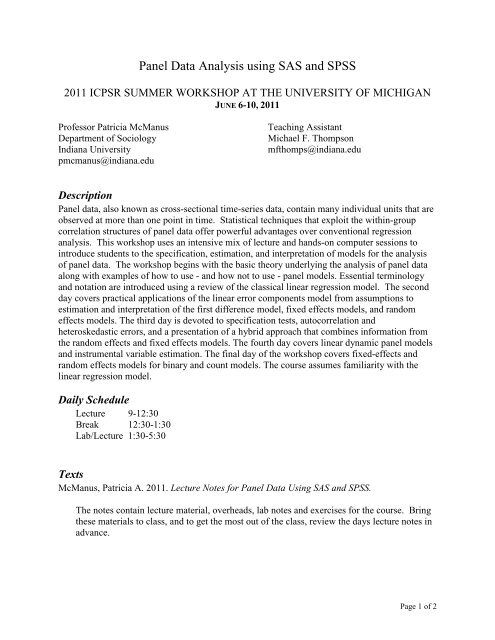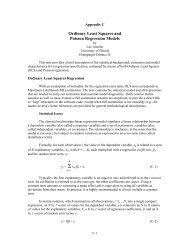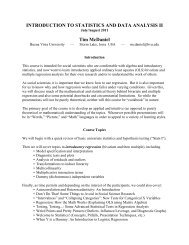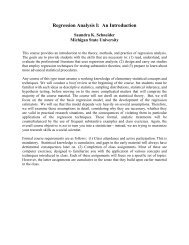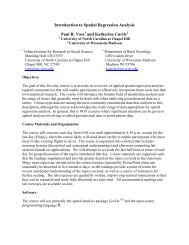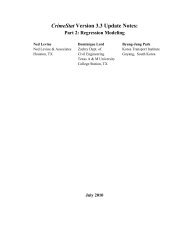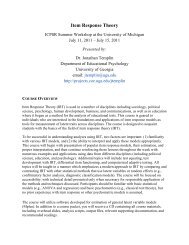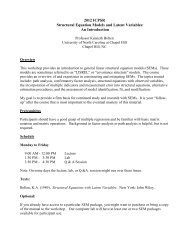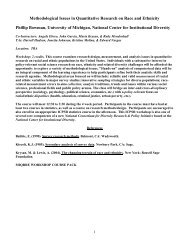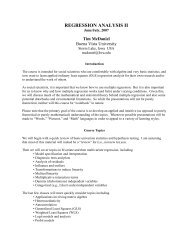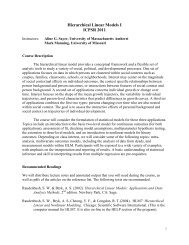Panel Data Analysis using SAS and SPSS - icpsr - University of ...
Panel Data Analysis using SAS and SPSS - icpsr - University of ...
Panel Data Analysis using SAS and SPSS - icpsr - University of ...
Create successful ePaper yourself
Turn your PDF publications into a flip-book with our unique Google optimized e-Paper software.
<strong>Panel</strong> <strong>Data</strong> <strong>Analysis</strong> <strong>using</strong> <strong>SAS</strong> <strong>and</strong> <strong>SPSS</strong><br />
2011 ICPSR SUMMER WORKSHOP AT THE UNIVERSITY OF MICHIGAN<br />
JUNE 6-10, 2011<br />
Pr<strong>of</strong>essor Patricia McManus<br />
Department <strong>of</strong> Sociology<br />
Indiana <strong>University</strong><br />
pmcmanus@indiana.edu<br />
Teaching Assistant<br />
Michael F. Thompson<br />
mfthomps@indiana.edu<br />
Description<br />
<strong>Panel</strong> data, also known as cross-sectional time-series data, contain many individual units that are<br />
observed at more than one point in time. Statistical techniques that exploit the within-group<br />
correlation structures <strong>of</strong> panel data <strong>of</strong>fer powerful advantages over conventional regression<br />
analysis. This workshop uses an intensive mix <strong>of</strong> lecture <strong>and</strong> h<strong>and</strong>s-on computer sessions to<br />
introduce students to the specification, estimation, <strong>and</strong> interpretation <strong>of</strong> models for the analysis<br />
<strong>of</strong> panel data. The workshop begins with the basic theory underlying the analysis <strong>of</strong> panel data<br />
along with examples <strong>of</strong> how to use - <strong>and</strong> how not to use - panel models. Essential terminology<br />
<strong>and</strong> notation are introduced <strong>using</strong> a review <strong>of</strong> the classical linear regression model. The second<br />
day covers practical applications <strong>of</strong> the linear error components model from assumptions to<br />
estimation <strong>and</strong> interpretation <strong>of</strong> the first difference model, fixed effects models, <strong>and</strong> r<strong>and</strong>om<br />
effects models. The third day is devoted to specification tests, autocorrelation <strong>and</strong><br />
heteroskedastic errors, <strong>and</strong> a presentation <strong>of</strong> a hybrid approach that combines information from<br />
the r<strong>and</strong>om effects <strong>and</strong> fixed effects models. The fourth day covers linear dynamic panel models<br />
<strong>and</strong> instrumental variable estimation. The final day <strong>of</strong> the workshop covers fixed-effects <strong>and</strong><br />
r<strong>and</strong>om effects models for binary <strong>and</strong> count models. The course assumes familiarity with the<br />
linear regression model.<br />
Daily Schedule<br />
Lecture 9-12:30<br />
Break 12:30-1:30<br />
Lab/Lecture 1:30-5:30<br />
Texts<br />
McManus, Patricia A. 2011. Lecture Notes for <strong>Panel</strong> <strong>Data</strong> Using <strong>SAS</strong> <strong>and</strong> <strong>SPSS</strong>.<br />
The notes contain lecture material, overheads, lab notes <strong>and</strong> exercises for the course. Bring<br />
these materials to class, <strong>and</strong> to get the most out <strong>of</strong> the class, review the days lecture notes in<br />
advance.<br />
Page 1 <strong>of</strong> 2
Recommended Texts<br />
Wooldridge, Jeffrey M. 2010. Econometric <strong>Analysis</strong> <strong>of</strong> Cross Section <strong>and</strong> <strong>Panel</strong> <strong>Data</strong>, 2 nd<br />
Edition. Cambridge, MA: MIT Press.<br />
Allison, Paul D. 2005. Fixed Effects Regression Methods for Longitudinal <strong>Data</strong> Using <strong>SAS</strong>.<br />
<strong>SAS</strong> Press.<br />
These texts will prove useful after the workshop. If you are already familiar with <strong>and</strong><br />
comfortable with the level <strong>of</strong> presentation in Wooldridge (2010), you will find the pace <strong>of</strong><br />
this course too slow. Allison (2005) is a slim <strong>and</strong> very accessible introduction to fixed<br />
effects models in <strong>SAS</strong> for applied data analysts, <strong>and</strong> includes several chapters on nonlinear<br />
fixed effects models. Unfortunately, it does not include coverage <strong>of</strong> <strong>SAS</strong>/ETS <strong>and</strong> PROC<br />
PANEL.<br />
Workshop Outline<br />
Each topic below will be included in the workshop, but the time spent on each topic will vary<br />
based on student background <strong>and</strong> interests.<br />
1. Overview: introduction to panel data, advantages, disadvantages, examples, common<br />
errors (Day 1)<br />
2. Review <strong>of</strong> general linear model: assumptions <strong>of</strong> single-equation linear regression model<br />
<strong>and</strong> estimation in the presence <strong>of</strong> heteroskedastic or correlated error structures <strong>using</strong><br />
OLS, GLS, FGLS (Day 1)<br />
3. Pooled Cross-Sections & Difference-in-Difference <strong>Analysis</strong> (Day 1)<br />
4. Error components models: first differences model, fixed effects, r<strong>and</strong>om effects (Day 2)<br />
5. <strong>Panel</strong> data workflow <strong>and</strong> decision tree: Specification tests, serial correlation <strong>and</strong><br />
heteroskedastic errors in panel models (Days 2-3)<br />
6. The Mundlak transformation hybrid panel model (Day 3)<br />
7. Dynamic panel models: instrumental variables & GMM approaches (Days 4-5)<br />
8. <strong>Panel</strong> models for dichotomous outcomes: FE (conditional) logit <strong>and</strong> RE logit <strong>and</strong> probit,<br />
fixed effects models for count outcomes (Day 5)<br />
9. Introduction to generalized estimation equations (GEE) for population-averaged effects<br />
(Day 5)<br />
Page 2 <strong>of</strong> 2


